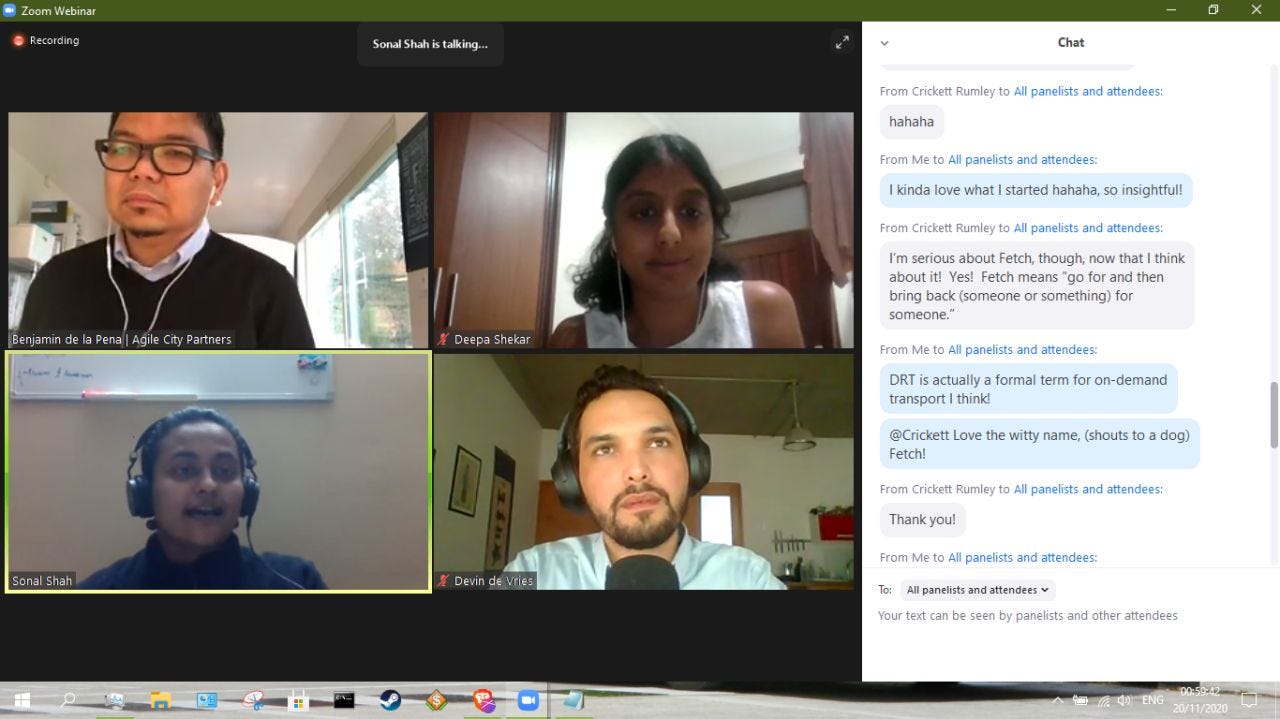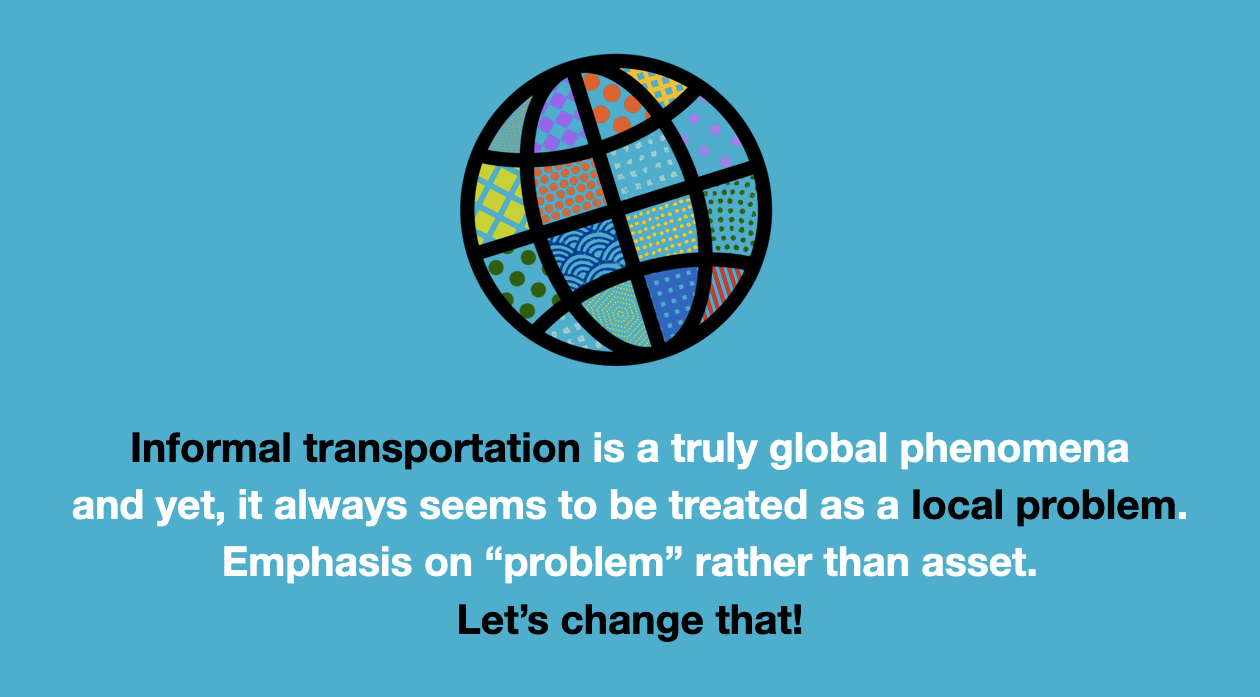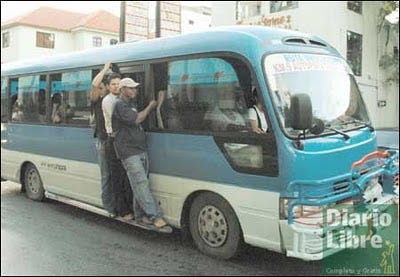Hey there! How are ya?
You good? I hope you’re good!
I’m good!
…
Forgive me, I’m still a bit giddy.
It might be from the heavy dose of cholesterol from the holiday dinner.
(Belated Happy Thanksgiving, y’all!)
It might be from last week’s launch of the Global Partnership for Informal Transportation at CoMotion LA Live.
“Goaaaalllllll!!!!!!”
I said I wanted to do it.
You said, “why not?”
We did it.
Thank you for your encouragement. Thank you for sending replies in private and for commenting here.
You know, your notes and comments do mean a lot to me. Bright spots in this covfefe of a year. So…
The assist
Giddy-ness aside, I am thankful. Very.
Everyone we’ve talked to agrees that this is timely and it is time to change the narrative and our understanding of informal transportation.
The set up
We followed up the announcement with a fantastic panel on the last day of CoMotion.
Thank you Deepa, Devin, Nadjeli, and Sonal for a wonderful conversation.
One of our last questions to the panel was, “What should we put in the center of the agenda for the Global Partnership?”
They said:
Representation and participation of operators
A mindset of celebrating the decentralization of informal transport
A focus on user needs, especially women
Support in digitalization processes
(Margarita volunteered “a transition to cleaner technologies.” I wholeheartedly agree.)
From the stands

The conversation on the chat was also exciting, especially on the continuing conundrum of what to call this sector. Some of you actually appreciated my bringing up Mean Girls (again).
Crickett suggested “Fetch Mobility.” Somebody else quipped “On Wednesdays we take the Pink Line.” (Ha!)
I think we’ll stick with Informal Transportation for the Partnership. (Duh, it’s in the name!) But we’ll work to change perceptions, no matter what we call it.
Playing to the crowd
After the thrill of last week, there was more good news this week. And, I’m not talking about the 375th time Biden was declared the winner of the US elections. (Seriously, whew!)
The WRI Ross Center for Sustainable Cities released their report on Informal and Semiformal Services in Latin America: An Overview of Public Transportation Reforms.

The report “examines the integral role of semi-formal and informal transport services as viable and legitimate public transport options in Latin America. While the region is well-known as the ‘cradle of bus rapid transit,’ the prevalence of semi-formal transport is often overlooked or scrutinized in a negative light.”
The authors offer their definition:
What Are Semiformal and Informal Services?
Semiformal and informal transportation services generally refer to demand-responsive, unscheduled, and flexible public transportation services provided by self-organized small operators, in small to medium-sized motorized or nonmotorized vehicles, generally without effective regulatory frameworks (Jennings and Behrens 2017). A myriad of terms— some more positive-sounding than others—that describe these services include “traditional,” “artisanal,” “provisional,” “paratransit,” “illegal,” “alternative,” “clandestine,” “unregulated,” and “makeshift mobility.”
Of course, I added the emphasis because, hey!
It’s an excellent report, choc full of data about the sector that has largely been hard to find. Take for instance this chart showing fleet sizes and shares in 20+ cities.
Play with the team you have
The context of the report was examining how bus reform programs interacted with existing informal transportation services. They point out that bus reform programs are often too optimistic with assumptions, like imagining that the under resourced reform programs can ever replace informal systems.
The authors say that the programs grossly underestimate the total cost of undertaking reforms—in time, money, and political capital.
From their conclusion:
Bus-based public transportation is the primary mode of transportation in most Latin American cities. Semiformal and informal services play a major role as integral public transportation options, but they are often not adequately studied in the region….
There is no single pathway to improve and reform informal transportation. Policymakers must examine the potential advantages and disadvantages of the reform process and set realistic expectations. Given that the semiformal and informal sector serves more than half of all public transportation trips in Latin America (Salazar Ferro and Behrens 2015), the sector will continue to play an essential role as a viable public transportation option for a large proportion of citizens.
They point to a few places for improvement. The next chart appeals to Agile City Partners because it starts from what the customer says is important.
My only quarrel with the report (probably less the report than the presentation from IADB) is the continued use a “problematizing” frame. It starts with problems to solve rather than strengths to leverage.
I’m not dismissing the very real problems of informal transportation but what kind of new insights would we get if we start from seeing these systems as assets?
A few more goodies from the report. I really like the next chart.
It offers a taxonomy and lists local names! I think taxonomies and indigenous names help us to get to more systematic thinking about informal transportation.
I only wish the chart specified where the names were from because it’s hard to find these local names.
Who’s on first?
(I know, wrong team sport reference. I sports so hard.)
The one surprising resource I’ve turned to to find names are backpacking travel sites, like Lonely Planet and Rough Guides.
For instance, TIL that in the Dominican Republic, informal transit vans and minibuses are called guaguas.
Rough Guides give us local flavor:
The Dominican Republic’s informal system of guaguas, an unregulated nationwide network of private operators, is a distinctive experience that you should try at least once. An instant bond of familiarity is formed as passengers – mostly locals – are crammed four and five to a seat in these half-wrecked vans that often seem held together with little more than packing tape and a strategically placed bit of rope: Amway salespeople pester fellow passengers, Pentecostals proselytize to heathens, a bottle of rum is passed around and – on night runs when the guaguas are less crowded – somebody pulls out a guitar and everyone breaks into song. Aside from the local colour they provide, they’re worth using for the cheap fares and comprehensive coverage to all parts of the country. Guaguas are operated by teams of two, the driver and the cobrador, who sticks his head out of the sliding side door (assuming it hasn’t been torn off) and drums up business. If you want to catch one, just stand by the side of the road and wave your arms at one as it passes.
Visualizing the goal
Since telling you about it seems to helps me to score goals, can I just share this?
My Agile City Partners and I are dreaming of putting together a Global Encyclopedia of Informal Transportation Vehicles. Encyclopedia entries would be local names, but also: vehicle configurations, types of fuel, engine displacements, number of passengers, availability of digital data, etc. etc.
We think it could be something.
Yeah. It could be something.
What do you think?
Change the game
I leave you this week with this June 2019 interview with Onésimo Flores. Flores founded Jetty, a tech microtransit company operating in Mexico City. (Ala the ill-fated Chariot and Bridj.)
His description of what informal transportation does is spot on and pretty much characterizes how it works everywhere:
In Mexico City, what you have is precarious public transit. You have a relatively small publicly operated and subsidized service which, combined, move approximately 5.5 million trips daily. You have another network of transit, which is essentially privatized, run by thousands and thousands of small-scale entrepreneurs that face a tightly regulated fare: they cannot charge whatever they want. Anything beyond the set fare is constantly renegotiated with the government. The colectivos, the peseros, the microbuses, these guys are really the workforce of mobility in Mexico City. They move almost 12 million trips every day, more than double the publicly subsidized network.
Over the years this network of minibus operators has really saved the city from gridlock. They run without requiring government money. They charge a very low fare – approximately US$0.30 without fare integration. Despite the low fare, they are able to make a profit because they’ve learned to skimp on everything that matters to passengers: they have insurance with questionable coverage, they overwork their drivers, they undermaintain (sic) their vehicles, they continuously postpone the renewal of their fleets and they cram their vehicles to sometimes inhumane levels. So you have a sort of like a microeconomic problem, in which you have the very low prices and very high demand, but the quality of service is very low. Anyone that’s able to afford an alternative abandons public transit forever: they buy a motorcycle, they pay a taxi, they purchase a car. So, you have this terrible equilibrium, in which you have low-quality transit and you have a small minority of people clogging the street with cars.
I’m glad Flores gets it. Whether his venture works or not is beside the point. His intent is what matters: We need to take what works and get it to work better–for customers, for drivers, for operators, for cities, for the planet.
We need to change the game.
That’s it for now. I’ll be back in your inbox in a couple of weeks. Meanwhile, stay sane. Stay safe. Wear a mask.
If you like Makeshift Mobility, share it with a friend.
I’m Benjie de la Peña and I wear many hats. I co-founded Agile City Partners, and I am the Chair of the Global Partnership for Informal Transportation. I will be wearing other hats, soon. I believe makeshift mobility could be the single greatest lever to decarbonize the urban transport sector. My cats don’t understand but they cheer me on.












Thanks Benjamin for attending the presentation of our report on "makeshift mobility" with IADB
As discussed in Twitter , we see that semi-formal and informal transport as basic means of providing low cost, ample coverage and frequent transport in most of our cities, creating also employment and opportunities for entrepreneurs. Costs are also very low for government, as regulation is very basic (no large staffs to supervise), and no subsidies (important as funding is always an issue)
But, there are some big "buts", vehicles are often old and polluting, operations are very unsafe, and security is a concern, including women harassment. And drivers have extended hours and are very often outside the social security system
We propose not advancing full reforms but finding ways to tackle issues while keeping the benefits for the users, and including incumbents as the service providers to the extend possible
Thanks again for commenting and letting us learn more and continue the discussion.
More comments from you and your readers are welcome .
Dario Hidalgo